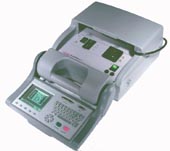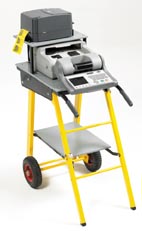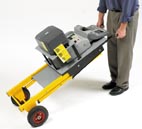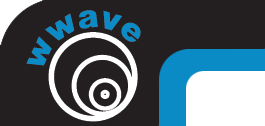|
Testing and
tagging Electricians that are qualified that come to you
and test your equipment on site for a fixed cost per test
tag!
Testing
and tagging enquiry form
|
|
Our Professional Testing and Tagging Systems
come in a fully Portable testing and tagging set up, for
easy movement around your site, office, school, workshop,
Nursing home or Hospital.
|
|
The core components of systems are:
|
|
|
* test tag printer for on-site printing
of durable and customised test tags which are attached to
you appliance or lead. |
 |
* an automated portable appliance
tester with memory for logging test and tag results
* software for downloading test and tag results, reporting
for logbook and asset management purposes |
 |
* barcode scanner for rapid data
entry on the tester such as asset description, make, model,
serial number, comments, asset site and asset location |
 |
To move this portable testing and
tagging unit we arrive with a lightweight, "A" frame
based trolley designed to transport the permanently mounted
Testing and tagging machine and test tag printer. |
 |
The "A" frame collapses for easy transport
and storage. Pneumatic tyres allow for easy transport over
uneven surfaces and stairs. |
| |
| Reason for using this tester: |
| This tester was designed from the
ground up to comply to AS/NZ3760:2003 like no other testing
and tagging machine on the Australian market. From 250V testing
of MOV devices through to leakage tests for Class II appliances
with an electronic switch, the Testing and tagging machines
software is fully customised to the requirements of AS/NZ3760:2003. |
| From its powerful testing and tagging
results recording and download capabilities to its user-friendly
interface characteristics, This testing and tagging machine
offers maximum scope for ensuring complete & accurate
testing and tagging, whether industrial machinery, construction
tools, extension leads, power boards or sensitive IT equipment
form the basis of your PATS program. In business, time is
money, so the speed of testing with this state of art tester
(when multiple earth paths exist, for example) will mean that
it is one of the best accident prevention investments you
could have. Rapid boot-up is complete in less than two seconds,
and a real-time clock eliminates the need for date entry.
Accurate earth bond and leakage measurement even when multiple
earth paths exist. Stores up to 5,000 memory locations including
appliance number, site, location, user, test status and date. |
| This is a Proven system: |
| This Testing and tagging System
was released in late 2001. It is now Australia's leading professional,
high volume testing, tagging and asset management system.
Users include government, schools, colleges, universities,
manufacturing, hotels, construction, mining, telecommunications,
broadcast, hire industry, electrical contractors and safety
consultancies around Australian and New Zealand. |
| Time is money and writing Test
tags and recording in a log book days are over: |
| Computer based automated systems
are improving efficiency across all areas of our daily lives.
It was only a matter of time before automated testing and
tagging systems were introduced that would dramatically decrease
the time spent on the manual processes of appliance testing,
log book entry and handwriting test tags. The benefits of
this new technology are not only improved testing throughput,
from 8 to 12 tests per hour up to 30 or more tests per hour,
more accountable and accurate record keeping for clients and
a guarantee that testing procedures fully comply to AS3760:2003
in ways that are impossible with the use of a multimeter and
an insulation tester when writing the test tags by hand. |
| Other benefit that relate to
after we have completed your tagging: |
| "New To Service" (NTS)
Software Utility allows Printer users to simply and quickly
print customised "New To Service" tags from a laptop
or personal computer connected to the Printer.
NTS tags are simply the best way to confirm the status
of new appliances or leads at a site as "newly"
installed. The benefit of asset owners attaching an NTS
tag to new items at the time of introduction are:
* Users can be assured that the "new" status of
a installed item is guaranteed and cannot be confused with
an untagged item.
* The individual responsible for testing and tagging items
at the site would be certain that the item is new to service
and was not omitted from a previous round of tests.
* The individual responsible for testing and tagging items
has all newly introduced items conveniently tagged with
an appliance number and appliance number bar code, which
speeds up the test procedure.
NTS tags are customised with the service provider's name
and phone number. This is an ideal way to either promote
the service or highlight the individual responsible for
testing and tagging items.
NTS tags can be printed in advance, e.g. a roll of 100 tags
and supplied to the individual responsible for appliances
and leads at a site. NTS tag users should be instructed
to tag all new items at time of introduction at that site.
You can even use colour coding for NTS tags for easy identification
and to ensure that they are not confused with appliance
test tags, e.g. use orange for NTS tags if orange is not
used for AS3760 tag colour coding at the site
|
| Complying to Australian Regulation
AS3760:2003 |
| If your current testing and tagging
program simply involves the use of a multimeter and an insulation
tester or the low cost Pass/Fail PAT testers on the market,
then you should be aware that this type of testing does not
comply with the requirements of AS/NZ3760:2003. It is now
mandatory for leakage current tests to be undertaken with
Class I and Class II equipment that has an electronic, magnetic
or membrane type on/off switch. Most modern office equipment
uses membrane type On/Off electronic switches as do many power
tools. Examples of magnetic switches include new toasters
(which will not latch without power applied) and some new
power tools. Insulation testing of these appliances no longer
complies with AS3760:2003. Such appliances must be powered
to get past the electronic or magnetic switch. You may be
passing an appliance, which has a fault beyond the switch!
Under these types of circumstances, a Class I item requires
a leakage current test to be with maximum leakage of 5mA
and a Class II item requires a leakage current test to be
conducted with a maximum leakage of 1mA. These types of
tests must be available on your appliance testing instrument
to comply to AS/NZ3760:2003 and are not found on any handheld
testers or models that are manufactured to British or other
overseas standards. The Testing and tagging Machine Wwave
uses was designed from the ground up to comply to AS3760:2003.
All Class I appliances have a protective earthing conductor
as their safeguard against electrical faults. The tester
allow for testing of this earth connection with a current
of 25A, stressing the earth connection and searching for
poor earth connections of a few strands or less. This cannot
be achieved with a digital multimeter or an insulation tester,
but only with a dedicated appliance tester that provides
a 25A earth bond test.
The use of anything other than a 25A appliance tester is
only checking the earth continuity, and not the integrity
of the earth bond. In a worst case scenario, an appliance
tested with a multimeter or insulation tester may return
a pass reading for earth continuity, but in reality was
only connected by a single strand with would burn out. If
the appliance subsequently developed a fault and fault current
flowed through the earth conductor fusing the connection,
the appliance will then look for a suitable earth, which
could be the operator, a 25A earth bond test is widely regarded
as "Best Practice" for testing the earth connection
of an appliance.
|
For a some help with your Testing and tagging
Click here or phone one of our friendly consultants
a call on +61 03 9372 5244
or Fax us on +61 03 9372 5211
or email on Info@wwave.com.au
|

